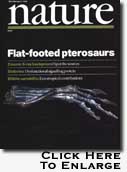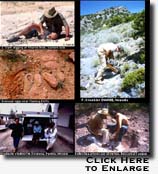
|


|
James M. Clark
Ronald Weintraub Associate Professor of Biology
Systematics and Paleontology of Dinosaurs and Crocodylomorpha
Department of Biological Sciences
George Washington University
2023 G Street. NW
Washington, D.C. 20052
344 Lisner Hall (office); 401 Bell Hall (lab)
Tel. Lab: (202) 994-9210
Tel. Office: (202) 994-7144
Tel. Secretary: (202) 994-6090
Fax: (202) 994-6100
E-Mail: jclark@gwu.edu
|
Education:
A.B. (University of California, Berkeley, 1978)
M.S. (University of California, Berkeley, 1985)
Ph.D. (University of Chicago, 1986)
Post-Doctoral Work: Zoology Department, U.C. Davis (1987-1989), National Museum
of Natural History (1989-1991), American Museum of Natural History (1991-1994).
Research Interests:
 My research addresses the interpretation of fossil land vertebrates (tetrapods), especially those from fossil deposits of
the Age of Dinosaurs (the Mesozoic). My field work includes participation in the American
Museum of Natural History-Mongolian Academy of Sciences expeditions to the Gobi Desert of Mongolia from 1991 to 2002
(at times as co-field leader), and
extensive work in Mexico. My current NSF-funded field project is an exploration of the Middle to Late Jurassic Shishugou Formation of Xinjiang, China,
in collaboration with Dr. Xu Xing of the Institute of Vertebrate Paleontology and Paleoanthropology, Beijing (click on the
icon to the left for images and reports from the field). Research
projects focus upon the evolutionary relationships of birds to theropod dinosaurs, based upon the collections from the
Gobi Desert of Mongolia and China, and the function of the foot of pterosaurs based upon a new specimen
from the Early Jurassic of Mexico.
My research addresses the interpretation of fossil land vertebrates (tetrapods), especially those from fossil deposits of
the Age of Dinosaurs (the Mesozoic). My field work includes participation in the American
Museum of Natural History-Mongolian Academy of Sciences expeditions to the Gobi Desert of Mongolia from 1991 to 2002
(at times as co-field leader), and
extensive work in Mexico. My current NSF-funded field project is an exploration of the Middle to Late Jurassic Shishugou Formation of Xinjiang, China,
in collaboration with Dr. Xu Xing of the Institute of Vertebrate Paleontology and Paleoanthropology, Beijing (click on the
icon to the left for images and reports from the field). Research
projects focus upon the evolutionary relationships of birds to theropod dinosaurs, based upon the collections from the
Gobi Desert of Mongolia and China, and the function of the foot of pterosaurs based upon a new specimen
from the Early Jurassic of Mexico.
Research:
 Dinosaurs and the Origin of Birds. The theropod dinosaurs and primitive birds collected by the AMNH-MAS expeditions to the Gobi Desert include
numerous skeletons providing important new information on the relationships of birds to other dinosaurs. Among these are the first embryonic
dinosaur skeleton from Mongolia and specimens of oviraptors sitting on nests in a bird-like position. My NSF-funded research, in collaboration with M.
Norell, L. Chiappe, and P. Makovicky, focuses on the relationships among the closest relatives of birds, especially oviraptorids, dromaeosaurids,
troodontids, the bizarre therizinosaurs, and the unusual basal bird Mononykus. Supported by a $3 million NSF Tree of
Life grant in 2002 (along with J. Cracraft, G. Barrowclough, and S. Hackett), we are now developing an online database of
theropod and bird morphological characters including images of each character.
Dinosaurs and the Origin of Birds. The theropod dinosaurs and primitive birds collected by the AMNH-MAS expeditions to the Gobi Desert include
numerous skeletons providing important new information on the relationships of birds to other dinosaurs. Among these are the first embryonic
dinosaur skeleton from Mongolia and specimens of oviraptors sitting on nests in a bird-like position. My NSF-funded research, in collaboration with M.
Norell, L. Chiappe, and P. Makovicky, focuses on the relationships among the closest relatives of birds, especially oviraptorids, dromaeosaurids,
troodontids, the bizarre therizinosaurs, and the unusual basal bird Mononykus. Supported by a $3 million NSF Tree of
Life grant in 2002 (along with J. Cracraft, G. Barrowclough, and S. Hackett), we are now developing an online database of
theropod and bird morphological characters including images of each character.
 Locomotion in Pterosaurs. An exquisite skeleton of a primitive pterosaur from Huizachal Canyon in Mexico provides important information about the capacity for
walking and running in these animals. In particular, the joint at the base of the toes (the metatarsal-phalangeal joints) are nearly flat, preventing them from
bending back into a posture in which the animal walked or ran on its toes, rather than on the ball of its foot. This research is in collaboration with James
Hopson of the University of Chicago.
Locomotion in Pterosaurs. An exquisite skeleton of a primitive pterosaur from Huizachal Canyon in Mexico provides important information about the capacity for
walking and running in these animals. In particular, the joint at the base of the toes (the metatarsal-phalangeal joints) are nearly flat, preventing them from
bending back into a posture in which the animal walked or ran on its toes, rather than on the ball of its foot. This research is in collaboration with James
Hopson of the University of Chicago.
|
|
Thalattosaurs. Abundant isolated bones and articulated skulls of this obscure group of lizard-like reptiles distantly related to dinosaurs were collected in Nevada
and are currently being removed from their limestone matrix in acid baths. This work is in collaboration with Hans-Dieter Sues of the Royal Ontario
Museum and Nick Hotton of the National Museum of Natural History and funded by the National Geographic Society.
|
 Phylogeny of Crocodylomorpha. My dissertation work on crocodylomorph phylogeny identified the major clades in this large group, which includes living
crocodylians and a wide variety of extinct forms related more or less distantly to them. Clark (1994) presented a cladogram and data matrix for the
Crocodyliformes, and Clark et al. (2000) presented an analysis of the remaining crocodylomorphs.
Phylogeny of Crocodylomorpha. My dissertation work on crocodylomorph phylogeny identified the major clades in this large group, which includes living
crocodylians and a wide variety of extinct forms related more or less distantly to them. Clark (1994) presented a cladogram and data matrix for the
Crocodyliformes, and Clark et al. (2000) presented an analysis of the remaining crocodylomorphs.
|
|
Phylogenetic Studies of Fossils. Fossils offer important information about evolutionary relationships, but they also are difficult to study because of
they are invariably incomplete. My research explores the limitations and advantages of information from fossils, especially regarding the effect of missing
data and the inference of non-morphological features of fossils.
|
 Field Work. My field research, undertaken nearly every summer since my co-discovery of the Fruita Paleontological Area
in the Late Jurassic of Colorado with George Callison in 1975, has focused on fossil vertebrates in dinosaur-age deposits
(i.e., the Mesozoic). Two areas of special interest are the Cretaceous dinosaur deposits of Mongolia, as a member and
co-organizer of the American Museum of Natural History-Mongolian Academy of Sciences expeditions to the Gobi Desert since
1991, and an Early Jurassic locality in the Sierra Madre Oriental of Mexico I discovered in 1982 with R. Cifelli, in Huizachal
Canyon. Other field work includes expeditions to Late Triassic marine deposits of Nevada (with H.-D. Sues and N. Hotton),
Early Jurassic fluvial deposits of the Glen Canyon Group in Arizona (with D. Fastovsky and K. Padian), Early Jurassic
deposits in southern Arizona, Cretaceous-Tertiary boundary deposits of eastern Montana (with W. Clemens), Early Cretaceous
deposits of central Mexico (with R. Hernandez and M. Montellano), Jurassic deposits of Venezuela (with M. Sanchez-Villagra),
Tertiary deposits of Yemen (with I. Tattersall and P. Whybrow), and Cenozoic deposits of Vietnam (with I. Tattersall and J. Schwartz).
In 2000 I began a new field project in Middle to Late Jurassic deposits of Xinjiang, northwestern China along with Dr. Xu Xing.
Organized in collaboration with the Institute of Vertebrate Paleontology and Paleoanthropology in Beijing, this project is directed
towards discovering the earliest members of dinosaur lineages dominating the Cretaceous Period, including the theropod dinosaurs
most closely related to birds. For images and reports from the field click on the icon next to
Research Interests.
Field Work. My field research, undertaken nearly every summer since my co-discovery of the Fruita Paleontological Area
in the Late Jurassic of Colorado with George Callison in 1975, has focused on fossil vertebrates in dinosaur-age deposits
(i.e., the Mesozoic). Two areas of special interest are the Cretaceous dinosaur deposits of Mongolia, as a member and
co-organizer of the American Museum of Natural History-Mongolian Academy of Sciences expeditions to the Gobi Desert since
1991, and an Early Jurassic locality in the Sierra Madre Oriental of Mexico I discovered in 1982 with R. Cifelli, in Huizachal
Canyon. Other field work includes expeditions to Late Triassic marine deposits of Nevada (with H.-D. Sues and N. Hotton),
Early Jurassic fluvial deposits of the Glen Canyon Group in Arizona (with D. Fastovsky and K. Padian), Early Jurassic
deposits in southern Arizona, Cretaceous-Tertiary boundary deposits of eastern Montana (with W. Clemens), Early Cretaceous
deposits of central Mexico (with R. Hernandez and M. Montellano), Jurassic deposits of Venezuela (with M. Sanchez-Villagra),
Tertiary deposits of Yemen (with I. Tattersall and P. Whybrow), and Cenozoic deposits of Vietnam (with I. Tattersall and J. Schwartz).
In 2000 I began a new field project in Middle to Late Jurassic deposits of Xinjiang, northwestern China along with Dr. Xu Xing.
Organized in collaboration with the Institute of Vertebrate Paleontology and Paleoanthropology in Beijing, this project is directed
towards discovering the earliest members of dinosaur lineages dominating the Cretaceous Period, including the theropod dinosaurs
most closely related to birds. For images and reports from the field click on the icon next to
Research Interests.
|
SELECTED PUBLICATIONS
For reprint requests, please send an email to jclark@gwu.edu.
Courses:
BiSc 207 - Current Topics in Systematic Biology. A weekly discussion of
current topics in systematic biology, including readings of recent literature.
BiSc 215 - Vertebrate Phylogeny. A lecture and laboratory survey of
vertebrate phylogeny, emphasizing the basic relationships among major groups and their fossil records.
BiSc 216 - Morphological Systematics. Principles and methods of
phylogenetic analysis of organismal morphology, organized around the concept of homology, and the testing of
homology provided by phylogenetic analysis.
Students:
DEE ALLEN (M.S., Morphometrics of beaked whale skulls). Graduated 12/02
BRIAN ANDRES (M.S., Two new pterodactyls from China). Graduated 12/02
SAYANTAN BISWAS (Ph.D., Southeast Asian skinks; sayantan@gwu.edu)
MARIA del ROSARIO CASTANEDA (Ph.D., South American anoles; mrcasta@gwu.edu)
KARIN HERRMANN (Ph.D., Ankylosaurian and stegosaurian dinosaurs; krherr@gwu.edu)
MAUREEN KEARNEY (Ph.D., Phylogeny of amphisbaenians). Graduated 6/00
REGINA MUNTER (M.S., A new theropod dinosaur from the Early Jurassic of Mexico.)
Graduated 6/99
JON POWELL (Ph.D., Geobiology Program, The anatomy of the pelvic region of birds and crocodylians, and sexual
dimorphism in archosaurs). Graduated 12/99
A
WWW Links of interest:
 National Museum of Natural History National Museum of Natural History
 American Museum of Natural History American Museum of Natural History
 Willi Hennig Society Willi Hennig Society
 Society of Vertebrate Paleontology Society of Vertebrate Paleontology
 Society of Systematic Biology Society of Systematic Biology
|








